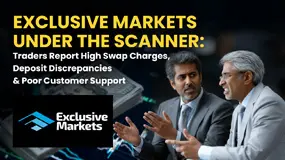简体中文
繁體中文
English
Pусский
日本語
ภาษาไทย
Tiếng Việt
Bahasa Indonesia
Español
हिन्दी
Filippiiniläinen
Français
Deutsch
Português
Türkçe
한국어
العربية
Saxo Bank vs. Fusion Markets: A Straightforward Broker Comparison
Abstract:When it comes to choosing a forex and CFD broker, traders often face a key question: do you go with a trusted, global institution like Saxo Bank, or a low-cost, flexible option like Fusion Markets? Both brokers offer unique advantages, but they’re built for very different types of users.

When it comes to choosing a forex and CFD broker, traders often face a key question: do you go with a trusted, global institution like Saxo Bank, or a low-cost, flexible option like Fusion Markets? Both brokers offer unique advantages, but theyre built for very different types of users.

Saxo Bank is a global investment bank that‘s been around since the early 1990s. It’s heavily regulated in major financial markets, including by the UK‘s Financial Conduct Authority (FCA), Australia’s ASIC, and Japan‘s FSA. It also offers strong client fund protection and participates in Denmark’s investor compensation scheme. This makes it one of the safest choices for traders who prioritize regulation, trust, and long-term stability.
Fusion Markets, on the other hand, is a newer broker focused on keeping costs low for everyday traders. It is regulated by ASIC in Australia but also holds offshore licenses like the Seychelles FSA, which offers weaker protections. This isnt necessarily a red flag for most users, but those who want full regulatory backing might be cautious.

In terms of what you can trade, Saxo Bank offers a huge product range with over 40,000 instruments across stocks, ETFs, bonds, futures, options, forex, and more. It‘s built for professionals and serious investors managing large, diverse portfolios. The broker’s SaxoTraderPRO platform provides powerful tools for experienced users, while SaxoInvestor is a simpler version for beginners who just want to buy and hold.
Fusion Markets takes a more focused approach. It offers forex, a few commodities, indices, and stock CFDs, but no crypto, bonds, or options. What it lacks in variety, it makes up for in platform choice and pricing. Traders can use MT4, MT5, cTrader, or even TradingView, making it perfect for those who want flexibility and the ability to automate strategies.

When it comes to cost, the difference is clear. Saxo Bank is expensive. Institutional and VIP clients may need to deposit $100,000 or more just to access preferred pricing. Spreads can be tight (as low as 0.4 pips), but commissions on other products like stocks and ETFs can add up quickly. In contrast, Fusion Markets is one of the lowest-cost brokers on the market. Theres no minimum deposit, and their Zero account offers raw spreads starting at 0.0 pips with just a $4.50 commission per lot, which is ideal for cost-sensitive traders and those testing out new strategies.
Customer service is another area where Fusion Markets shines. It offers 24/7 support through live chat, phone, and email. It also provides free educational content for beginners. Saxo Banks support is more limited, with service only available on weekdays, and some users report issues with login processes and platform navigation.
So, which broker is right for you? If you're a professional or high-net-worth trader looking for access to global markets under strong regulation, Saxo Bank is a solid choice. Its wide product range, institutional-grade tools, and long-standing reputation make it ideal for building and managing large portfolios.
But if you're a retail trader, just starting out, or focused on low-cost forex strategies, Fusion Markets is likely a better fit. Its simple to use, highly affordable, and offers more freedom when it comes to platform choice and strategy testing, without the pressure of large deposits.
Ultimately, your decision should depend on your goals, budget, and risk comfort. Saxo Bank offers depth and safety, while Fusion Markets offers speed, savings, and flexibility. Both serve different needs, and both do it well.

Disclaimer:
The views in this article only represent the author's personal views, and do not constitute investment advice on this platform. This platform does not guarantee the accuracy, completeness and timeliness of the information in the article, and will not be liable for any loss caused by the use of or reliance on the information in the article.
Read more

JP Markets Review: High Spread & Commission, Fake Bonus Lure & Withdrawal Hassles Frustrate Traders
Have you been lured into opening a JP Markets Forex Trading Account with a high bonus offer that never existed? Have you found the spread and commission charges higher on JP Markets Login than what’s advertised on the broker’s website? Wondering why you are not able to withdraw funds from your trading account? Well, all of these hint at a potential forex investment scam. Many traders have expressed their disappointment while sharing the JP Markets Review online. In this article, we have shared certain complaints. Take a look at them.

Angel one 2025 Review & Complaints
Angel One is a well-known name in the forex market. People are familiar with the name , but is this broker really worth your interest? What do real users say about Angel One, and what complaints have they shared? In this Angel One 2025 review, you will explore all these details.

Exclusive Markets Under the Scanner: Traders Report High Swap Charges, Deposit Discrepancies & More
Is your forex trading account experience at Exclusive Markets far from good? Do you witness high swap fees and daily charges? Does the deposit fail to reflect in your Exclusive Markets Login? Don’t receive adequate response from the customer support official on your trading queries? You are not alone! Traders have already alleged that the forex broker is involved in these activities. In this Exclusive Markets WikiFX review article, we shared some traders’ comments. Read on to know about them.

Interactive Brokers Fined for FINRA Market Data Lapses
Interactive Brokers fined $150,000 by FINRA over Vendor Display Rule violations and supervisory gaps; firm adds real-time consolidated data displays.
WikiFX Broker
WikiFX Broker
Latest News
Latest FCA Daily Alerts and Consumer Warnings for 2025
Webull Widens Crypto Futures with Coinbase Derivatives
Is Nash Markets Regulated or Risk? Truth About Nash Markets’ License & Withdrawal Issues
Angel one 2025 Review & Complaints
Exclusive Markets Under the Scanner: Traders Report High Swap Charges, Deposit Discrepancies & More
CySEC Blocks Certification Access to Combat Advisor Impersonation
Annual Sales Of New Vehicles Expected To Hit Only 15.7 Million Units: Cox
Saxo Bank Japan Expands European Stock Portfolio with UBS, Ferrari, and Other Major Names
Amillex Broker Affiliate Program: A Complete Guide to Earning with Referrals
New SC Rules Take Effect in November 2025: What’s Next for Finfluencers?
Currency Calculator



